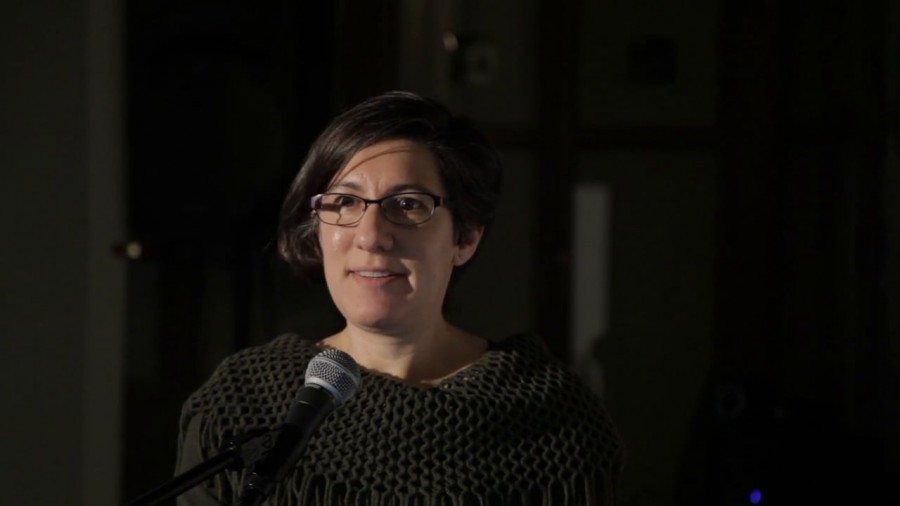Today I want to talk with you about some of the work that I’ve been doing this week with some students and post-docs. Rebecca, Darya, and Manya have been here helping me and doing a lot of the heavy lifting here.
As Golan mentioned, I did my sabbatical here about two years ago in the Studio and it was great fun. One of the things that I did while I was here besides making lots of quilts on all sorts of interesting designs and whatnot was that I made some quilts where I attempted to visualize privacy. Since my day job is to be a privacy and security researcher, it was a good way to convince my dean that my sabbatical was relevant to my career.
I want to tell you about a couple of these and then about the work that we’re doing this week. I went to to SXSW, and at Southby they have a trade show where they have all sorts of interesting startups who are trying to convince you that they’re going to be the next great thing. There was one of them called Beautécam. It was out of Japan, and they were handing out free lenses that you could attach to your cell phone to take very close-up, almost microscope images of your bad skin. The idea was they were building a social network where you could exchange pictures of your bad skin and get advice. This horrified me. I don’t want to look at my bad skin, let alone let other people look at it. And it seemed like really kind of ewww, and sort of privacy-invasive. But I like free stuff so I took one of their lenses and then I went home and started taking pictures of thing that were not my bad skin. So I took these beautiful images and was showing them to people, and people would look at them and say, “Wow that’s pretty but what is it?” And I realized that this privacy-invasive camera lens also served to kind of anonymize these images and made it really difficult for people to tell what they are.
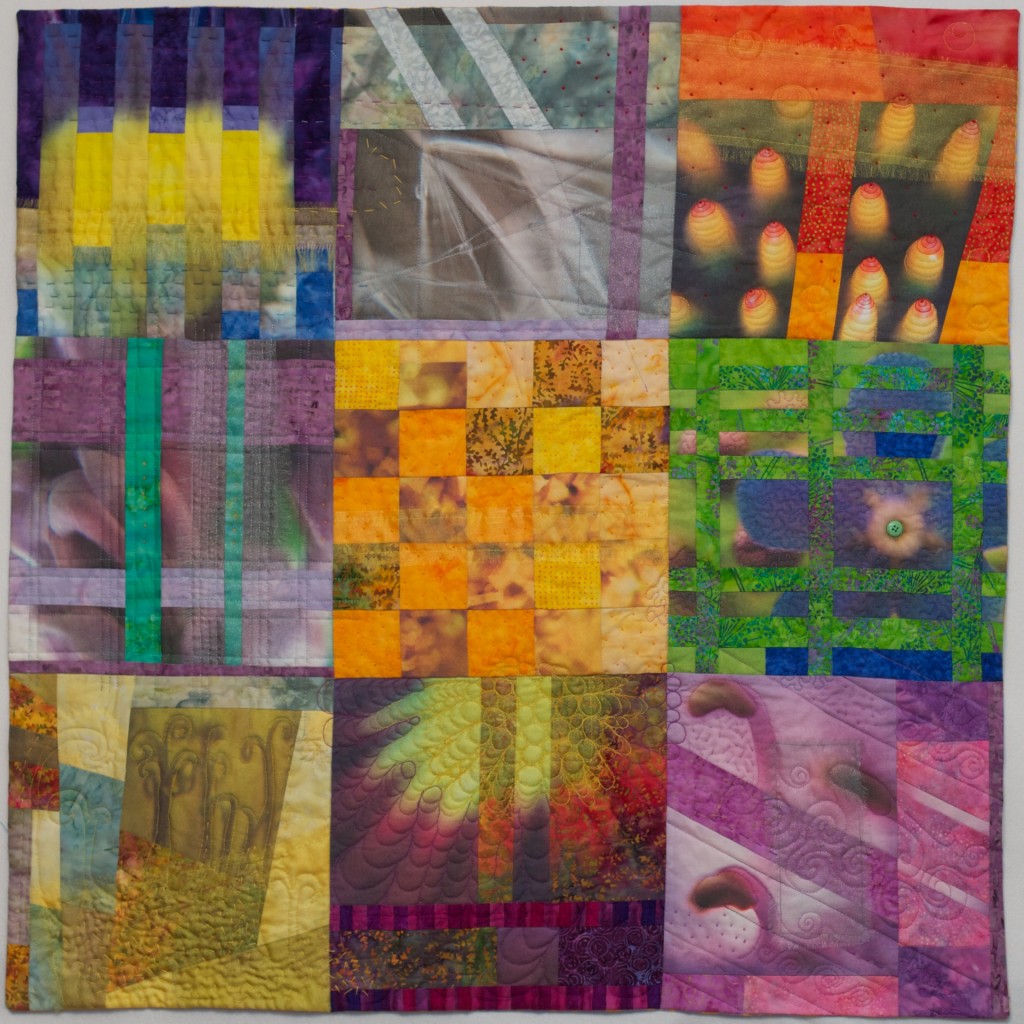
So I took a bunch of these images and digitally printed them on fabric, and then sliced and diced and did the kinds of things you do when you’re making a quilt, and made a quilt out of it. And this quilt is called “De-identification.” The quilt sort of tells the story of these images that are de-identified, and if you stare at it long enough you may start recognizing things in the images, and start being able to piece together what it actually is. And then once you can do that you can actually re-identify all of the images. I’ll give you a hint here. The blue thing with the green, that’s a forget-me-not flower. So that’s the size of my thumbnail. And so all of the other things are actually also flowers in this sort of microscopic view.
Another quilt that I worked on was based on trying to de-identify myself. I started with a picture of myself and then ran it through various filters, and then made it out of fabric. So this is the quilt I created, which is a self-portrait:
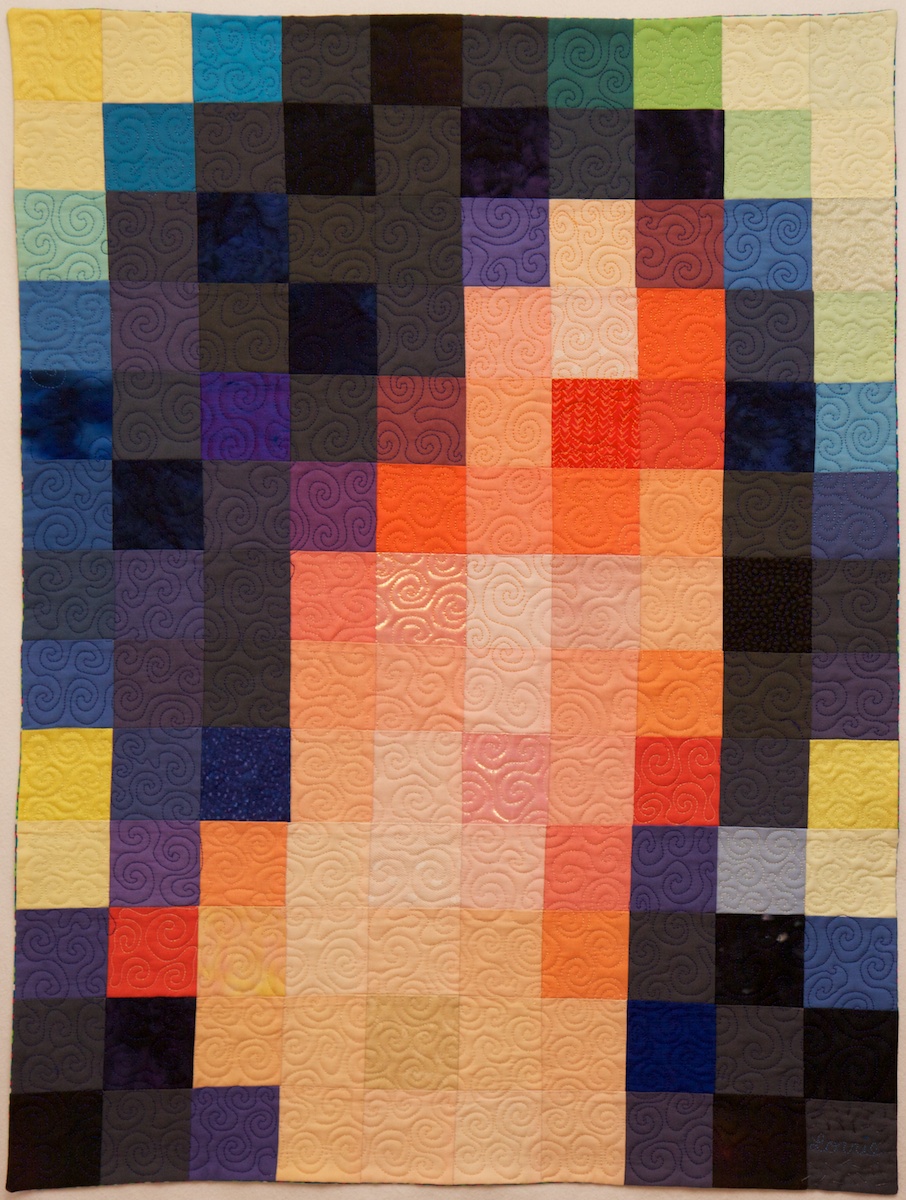
Lorrie Cranor, “Self Portrait”
I also looked at passwords. That was a project that I was working on a lot and actually still am. I actually came up with a title for this quilt before I came up with the design. It seemed to me that if I was making quilts related to security and privacy, one of them had to be called “Security Blanket.” It’s just the obvious choice. So then the next question was “What does a security blanket look like?” So I decided to take the 1000 passwords that occurred most frequently in a stolen password set, and make a word cloud out of them.
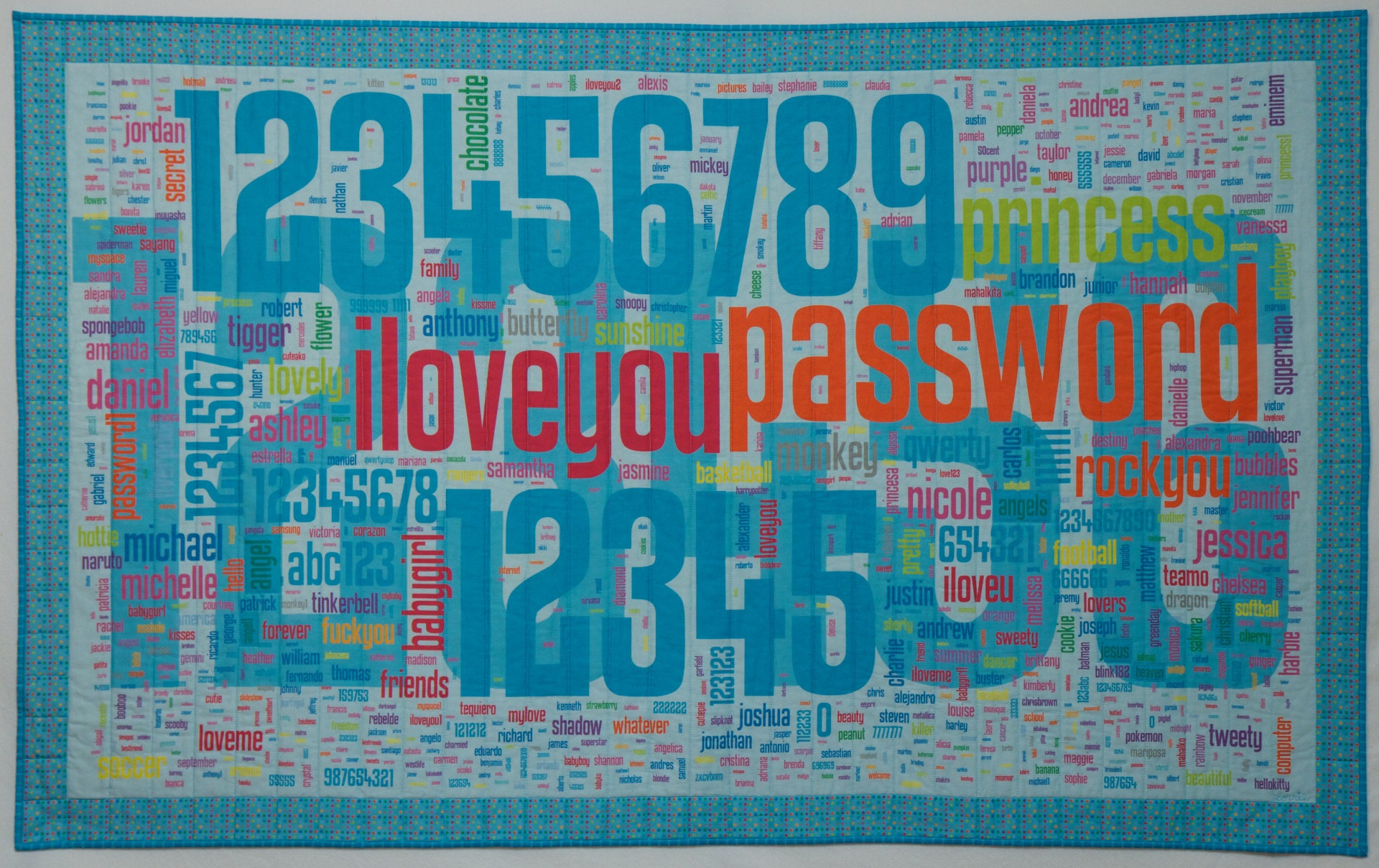
Lorrie Cranor, “Security Blanket”
You can see these are all really bad passwords. If you see your password here, go home and change it please. It really should not be your password. And so it seems fitting that they would go on a security blanket, which may give you some comfort, but no actual protection.
This was an interesting study. I spent a lot of time with this because they’re actually all color-coded on thematic areas, and I tried to figure out why people created passwords with things like “princess.” My speculation is that that’s one of the most common names for dogs and cats in the US.
This actually resulted in inspiring some additional research for my grad students. It also ended up appearing in Science magazine, which I thought was kind of cool. And then I decided I needed a dress to go with the quilt. So I made a dress, and then a friend of mine made a chair which I then had to buy from her and put it in my living room. And I’ve made the fabric available and so now other people are making dresses, shirts, and ties. Which is kind of cool.
So back to visualizing privacy. I have a lot of conversations with people about privacy when they ask me about my research and I tell them I do research on privacy, and they’ll tell me what they think about it. In some of our research studies we actually interview people or do surveys where we ask people to tell us what they think of when they think about privacy in certain situations.
I’ve also talked to my kids about privacy. They are always very curious about what I do at work. So they’ve given me their views on privacy, and they’ve really been kind of interesting. So I thought wouldn’t it be interesting instead of just going out and interviewing adults, let’s go and talk to kids about privacy, and let’s get them to draw. So last week we went into several classrooms in the area and asked the kids “What does privacy mean to you?” What do you think about when you think about privacy? Draw us some pictures. We went to a high school class, and we also went to a 3rd-grade, a 6th-grade, and a kindergarten. And we collected lots of drawings. Then we said well, what about adults? I wonder if adults would draw the same things or different things. And so we went on Mechanical Turk two days ago, and we asked a hundred people to draw us a picture of privacy for a dollar. And we got back lots of interesting drawings.
Then we printed everything out and we came up here on the stage and just kind of spread them all on the floor and looked for themes and patterns and saw what we could find. And we’ve spent the last two days putting this together and it will by the end of the week be a chapter in the book that the Deep Lab is putting together. I’m going to show you some of the things that I found here.
One of the most fundamental views of privacy is that it’s the right to be let alone, and there is a very famous article that describes it as the right to be let alone. And that’s what we see from the kindergarteners quite a bit. “Privacy is being by myself” says Emma, age 5:
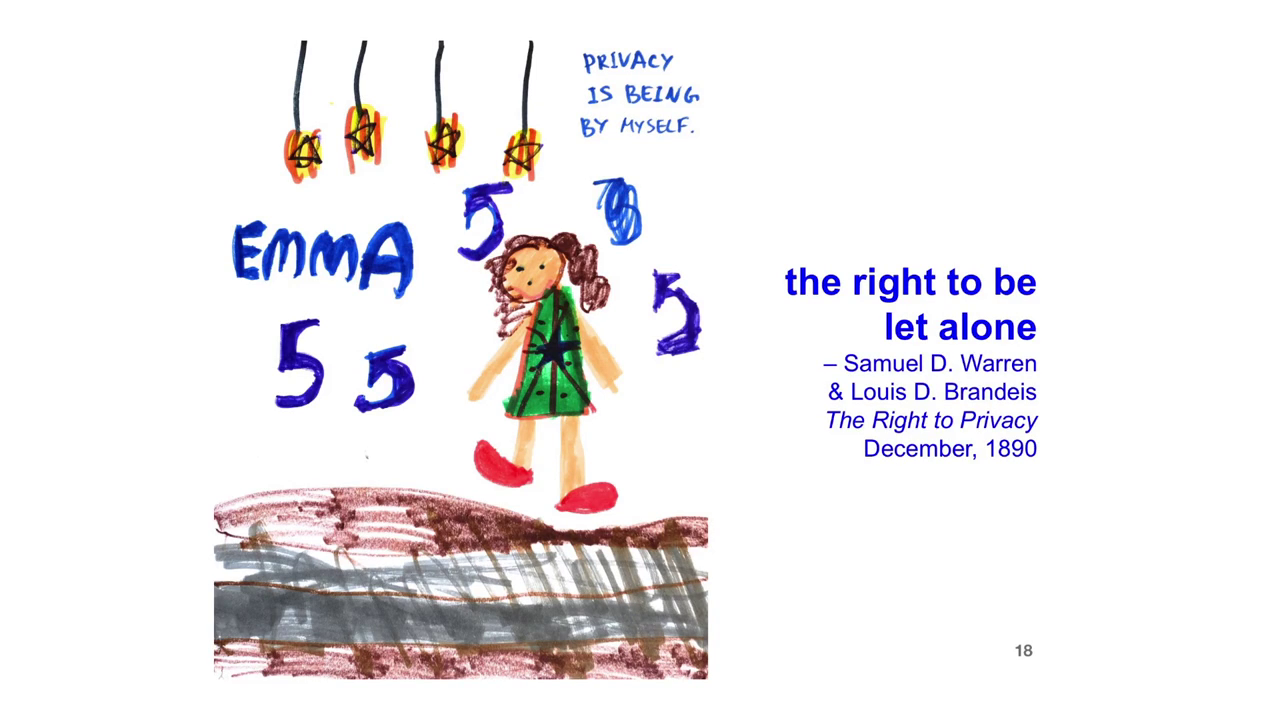
But we also get this from adults. “Privacy is the right to be by yourself. Privacy is isolation.”
We also see a lot from the kindergarteners that they have private places, a room, a clubhouse, bedrooms. And adults have these private places, too. And that’s what they associate with privacy.
We also find that blankets and covers are very popular. We had a lot of blanket and cover pictures from kids, some of which describe what they do under their covers that they don’t want other people in their house to see. But we also got some from adults as well, who drew these pictures of blankets.
We didn’t get very many pictures related to intimacy, but we did have one 8yr-old who drew a picture of her parents kissing behind a closed door, and presumably her or her siblings banging at the door and saying, “Open up.”
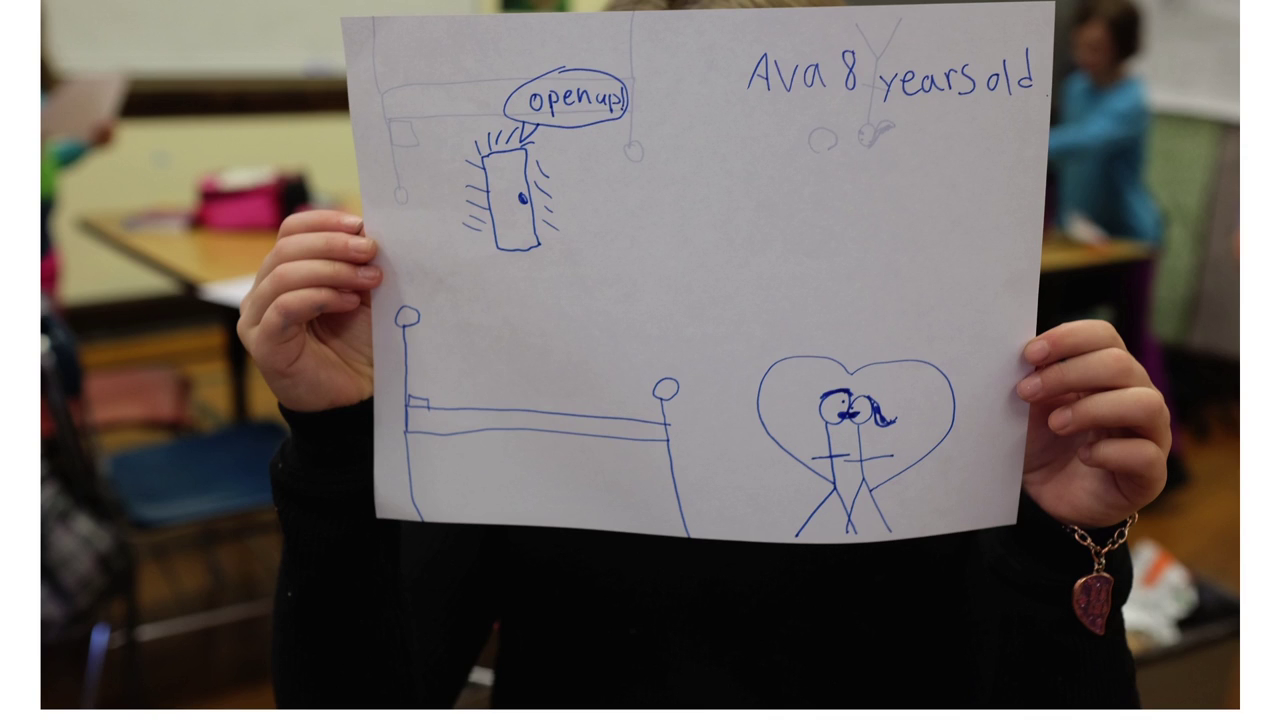
We had lots of pictures of siblings banging on doors, and siblings annoying each other and saying, “I need privacy from my sister or my brother.” Quite a few of those.
We also had privacy while changing. The picture on the left, it looks like a kid drew it but actually it was a 32yr-old who drew that, and on the right a 5yr-old. And they’re both changing.
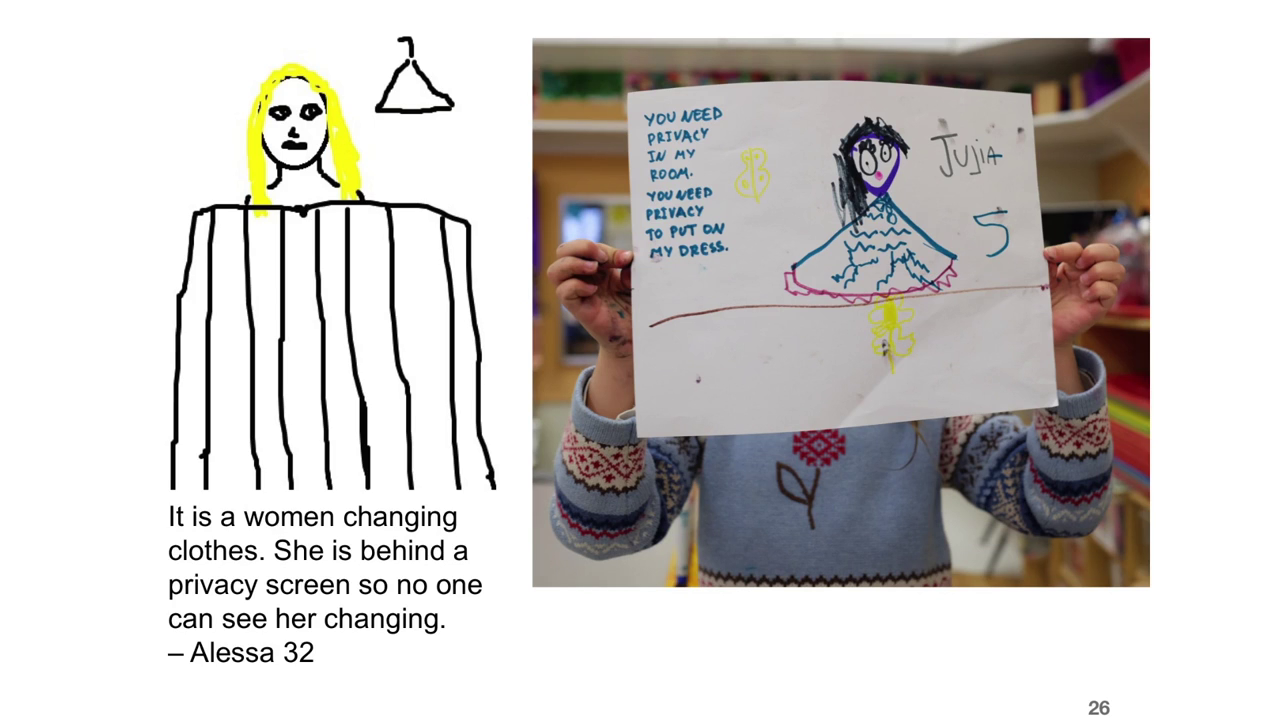
One of my favorite pictures from the kindergarteners is this one. “Spiderman needs privacy to put his costume on.” Very important.
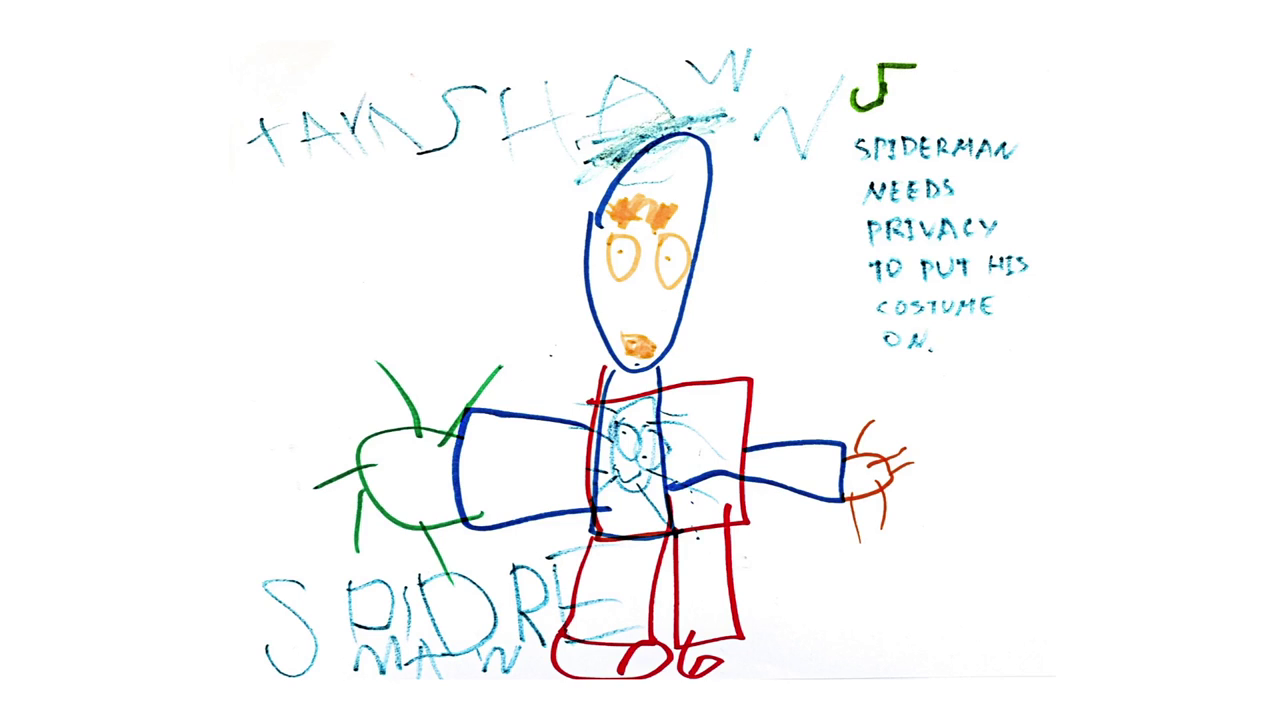
Another place where people want privacy is bathrooms, and we have a lot of potty pictures. We also have pictures of kitty cats. They need privacy when they go to the bathroom, too.
We have a bunch of interesting pictures from the 3rd-graders of people walking in on each other in the bathroom and they seem to always say “Aaahhhhh!” when it happens. We have a bunch of those.
Showering. You want privacy while showering so we have, this is a 3rd-grader who drew the one on the left, and then a 37yr-old who drew the one on the top. And he says, “Who wants to have an audience while taking a shower?”
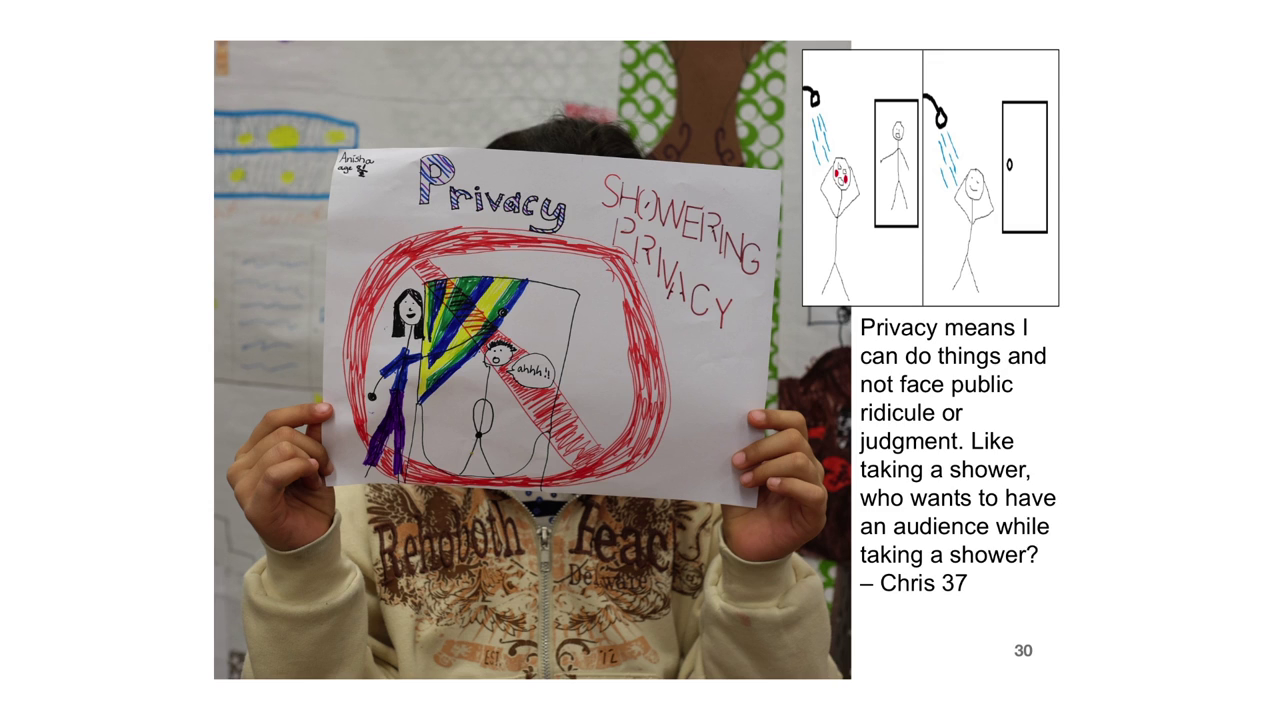
These are pictures from adults. These are both from mothers who say that the bathroom or some other personal room is the only place they can go to get away from their kids, their husbands, their dogs, and have some peace and quiet and privacy to theirselves, which was kind of interesting. All of the pictures we got in this category were all from mothers.
Doors. We have a lot of pictures of doors. Some very colorful doors, some not-so-colorful doors. These are from ages 5, 11, 16, and 34. But all expressing basically the same sentiment.
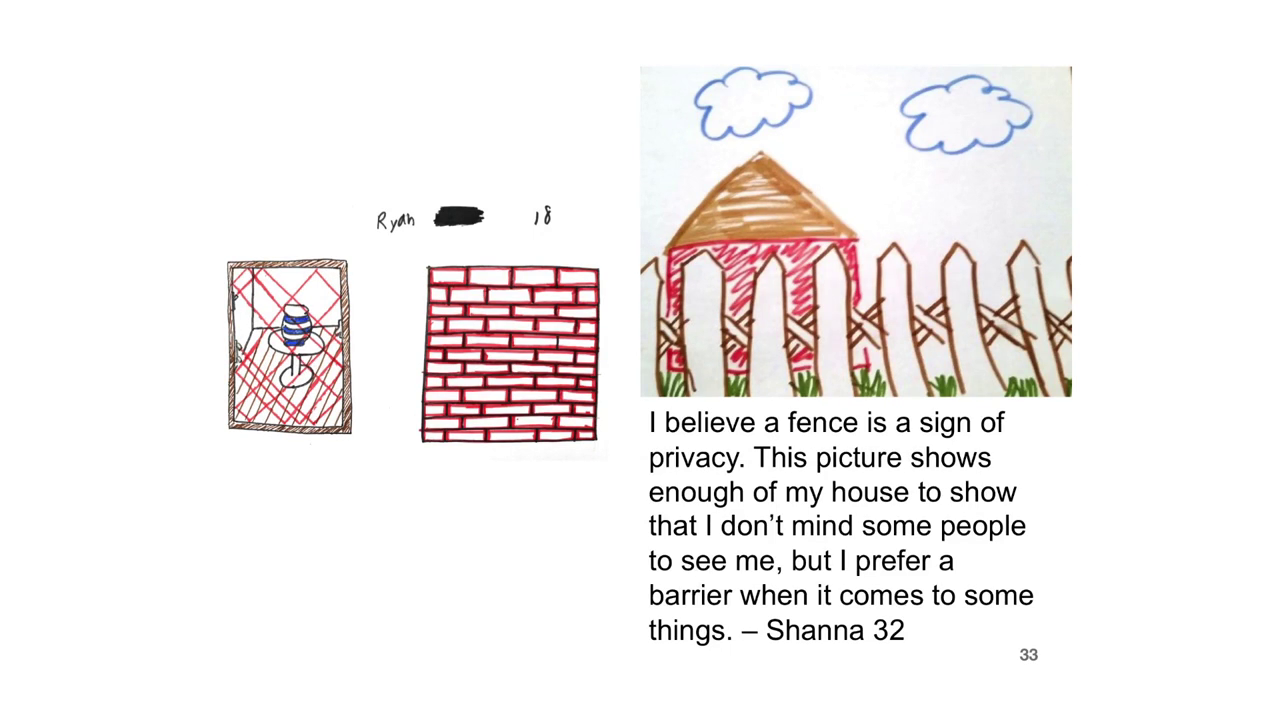
Related to that, we have fences and walls. A number of fences and walls and ways to guard things. The image on the left is actually an infrared security system. You can see the red light beams there.
Some people talked about personal bubbles. The one on the left is a 9yr-old who drew this personal bubble, which I think is starting to get to be a more sophisticated notion of privacy, that you can have this concept of a bubble around you. It’s not really a physically bubble around you where you have your privacy protected. And on the right we have another one that was drawn by a 21yr-old and she drew a bubble around herself. It looks like she’s sunbathing, maybe nude sunbathing. But she also drew an extra wall on the outside just in case. She didn’t trust the bubble.
Another notion of privacy that you read a lot about in the privacy literature is the notion of privacy as control. This is another very famous quote about privacy.
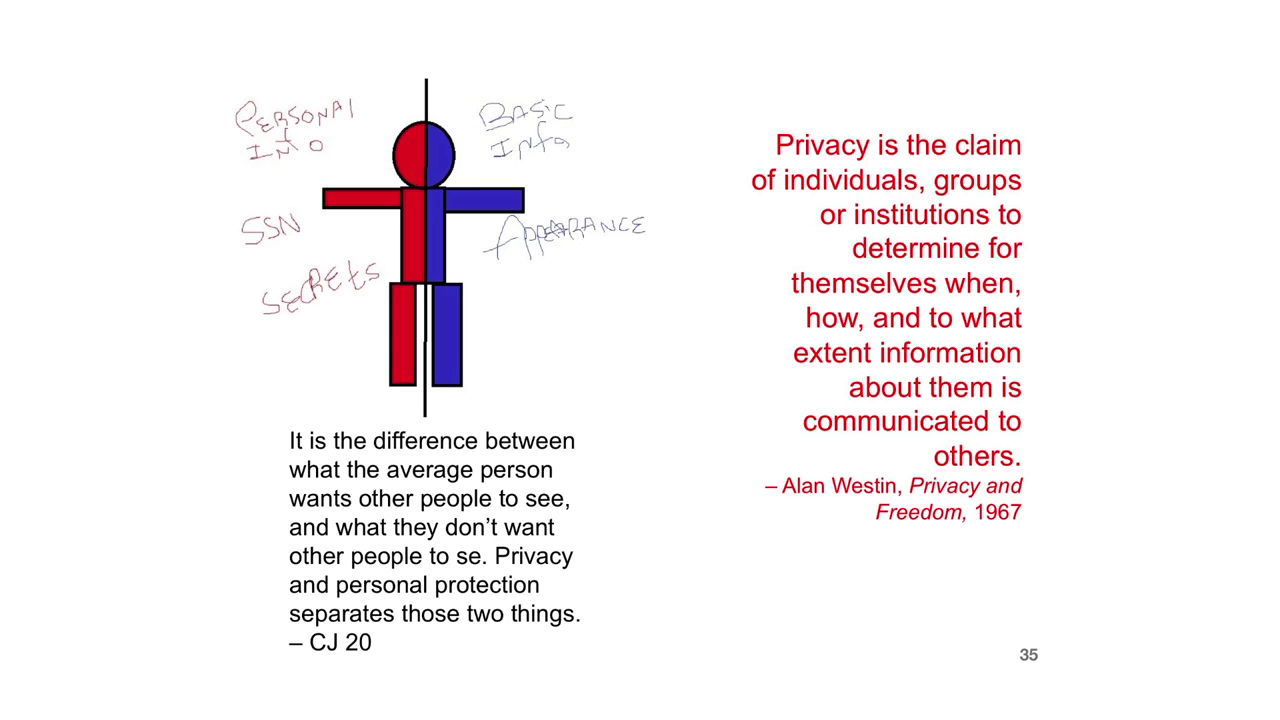
We actually didn’t get very many drawings of privacy as control, which is interesting because we see a lot in privacy policies where companies are talking about ways to control your privacy. One of the other things that we’re doing as part of this book chapter is we actually went through about a dozen privacy policies of big companies and looked for interesting things that they say about privacy. So a lot about control there, not so much with the people who drew pictures for us.
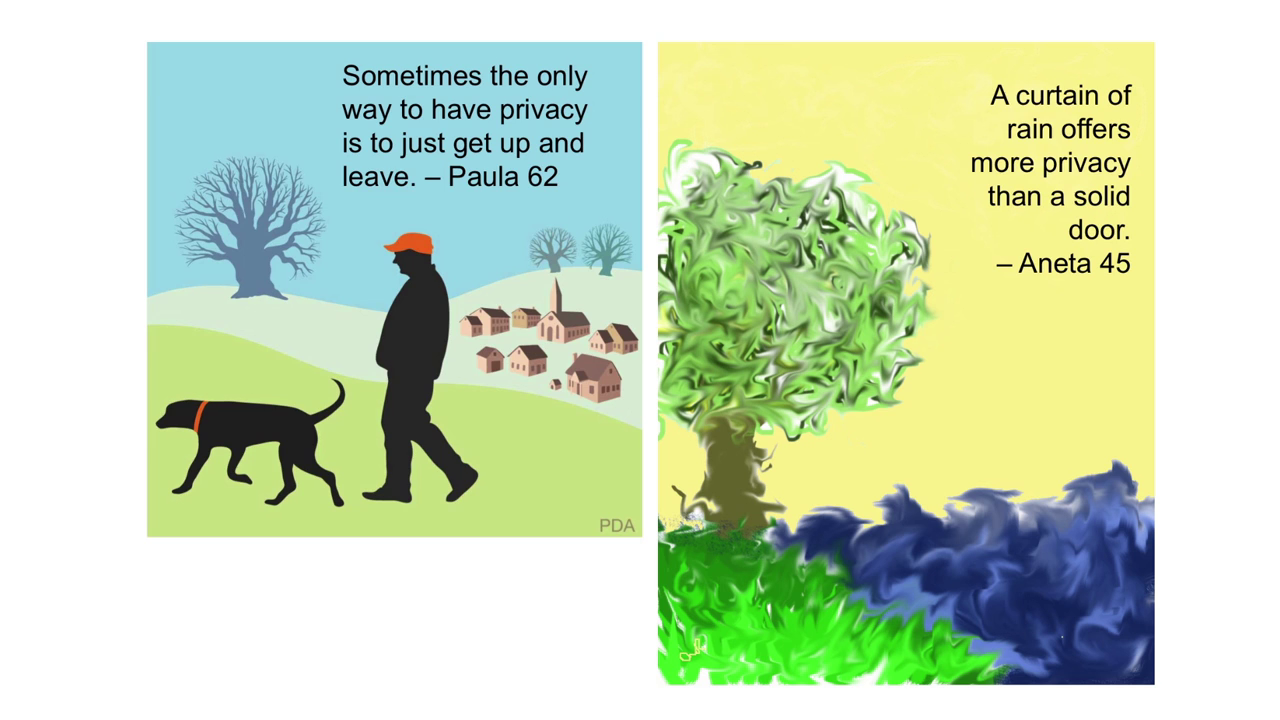
Some of our most beautiful pictures have to do with privacy in nature. People who told us that in order to really have privacy, they needed to get away from it all. These were some of our older people, so we have 62yr-old Paula says “Sometimes the only way to have privacy is to just get up and leave.” And Aneta says, “A curtain of rain offers more privacy than a solid door.” So very philosophical as well.
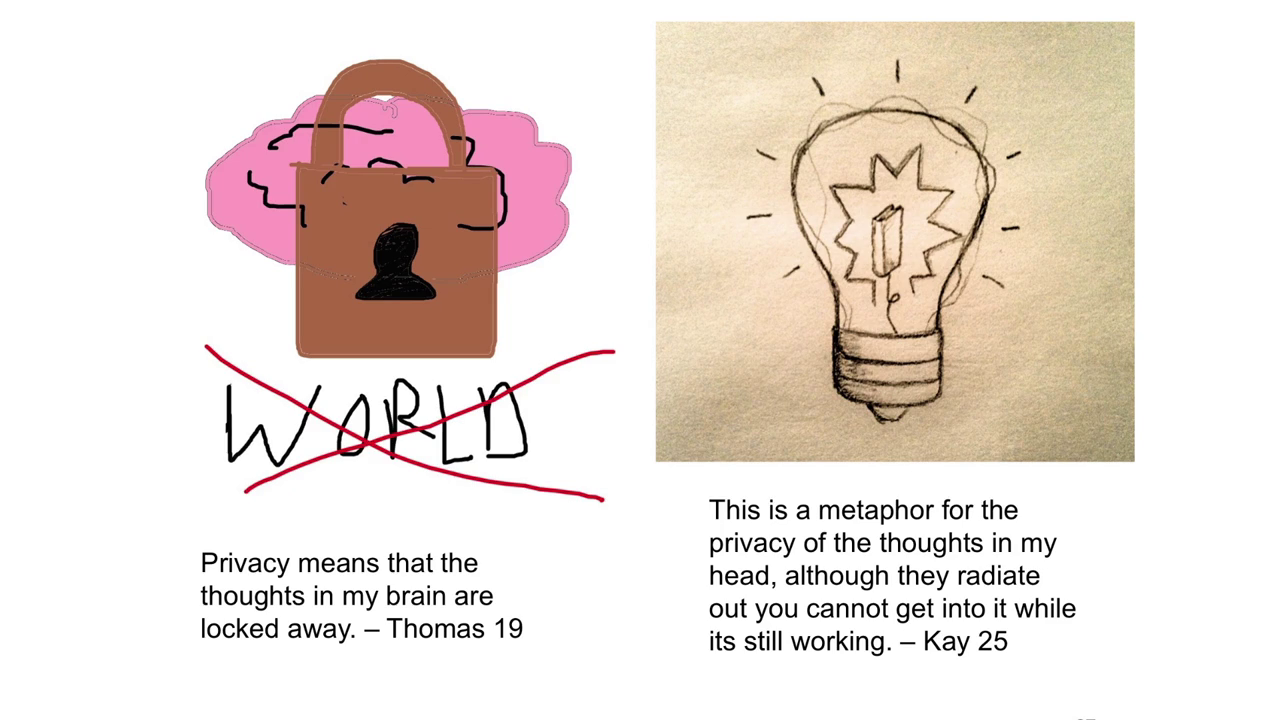
Some people told us about privacy in their thoughts. That pink thing is a brain. And the light bulb is a metaphor for privacy of thought.
Some of the kids told us about privacy while using computers and especially while texting. Here it’s not just their own thoughts that they’re keeping to themselves, but their thoughts they’re sharing with a friend or small number of friends. I was surprised that there was an 8yr-old who had a device to be texting but she does, apparently, and this is important to her.
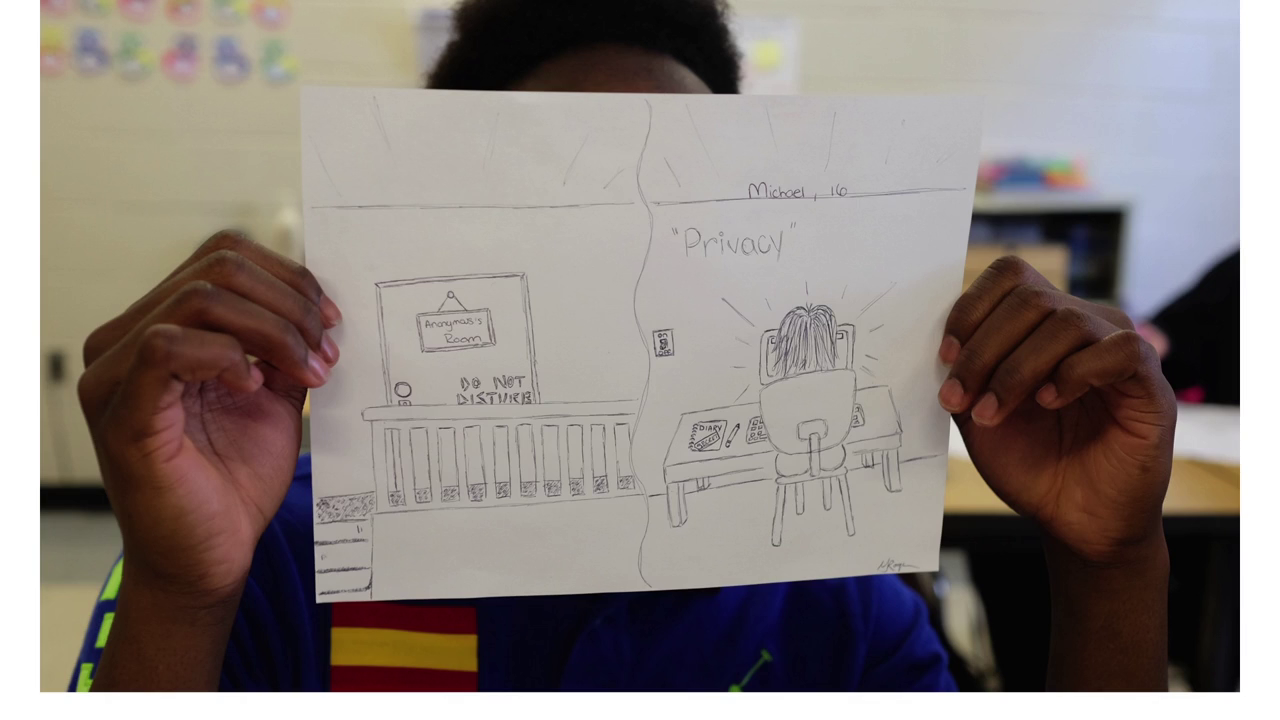
We saw this also with the high school students. This high school student talked about the privacy of the computer in his room and also pointed out the door lock as well on his room door.
Some of the kids told us that if you’re going to use computers, and especially if you’re going to use social networks, it’s your responsibility to protect your privacy and they drew pictures of various ways that you could protect your privacy when using social networks. We had some adults who talked about that as well, going “incognito” with your web browser.
We had some adults who drew concepts like encryption. And we had a bunch of people who drew password entry boxes and passcodes and various ways that you could electronically lock things, or physically lock things. We have a large collection of lock drawings now.
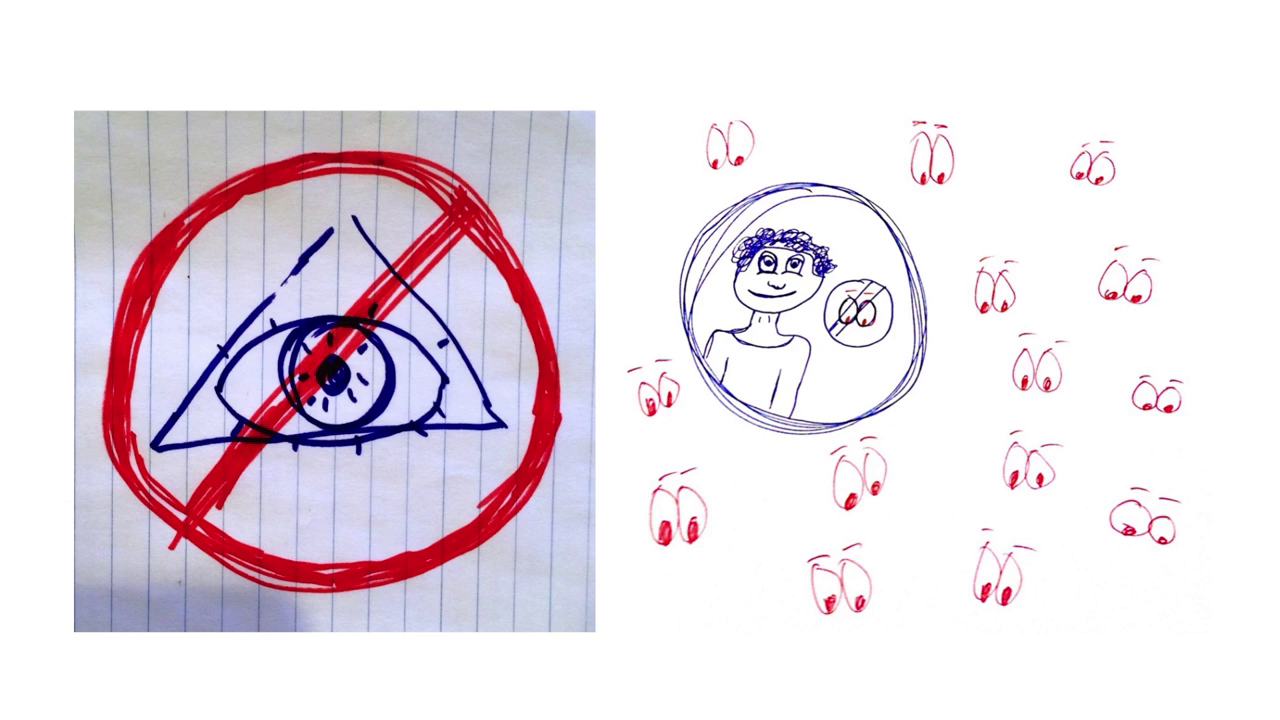
If you Google for “privacy” and look at the imagery associated with privacy, one of the things that you see a lot of is eyeballs. And we did get some eyes as well. We also got some video cameras and some NSA:
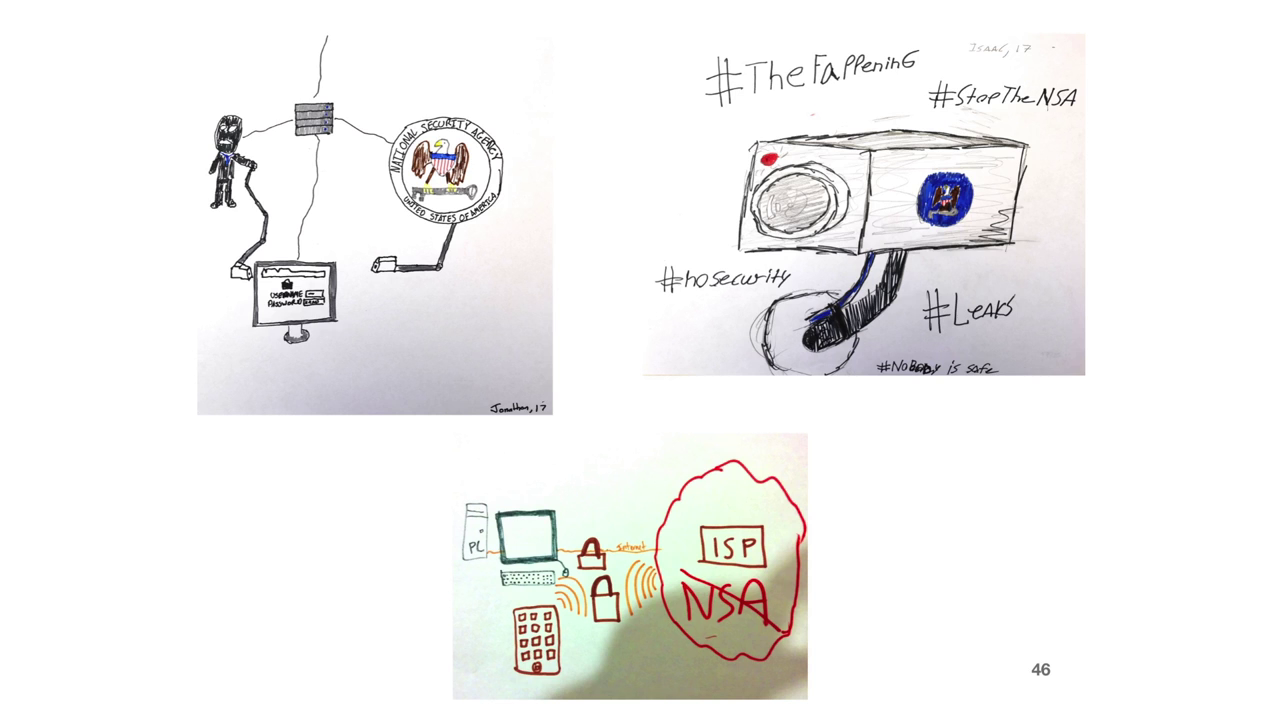
The two at the top were drawn by high school students, who as soon as I handed out the markers and said “draw privacy,” they immediately got out their laptops and Googled to find the NSA logo so that they could recreate it accurately. They knew that that’s what they wanted to draw. But we had adults who drew NSA stuff as well.
We had a few people talk about privacy in marketing. These were all adults. We did not actually get any kids who drew whole concepts with marketing. A few I think mentioned it in a sort of aside. But marketing and spam. Lots about social networks, both from teenagers and from adults.
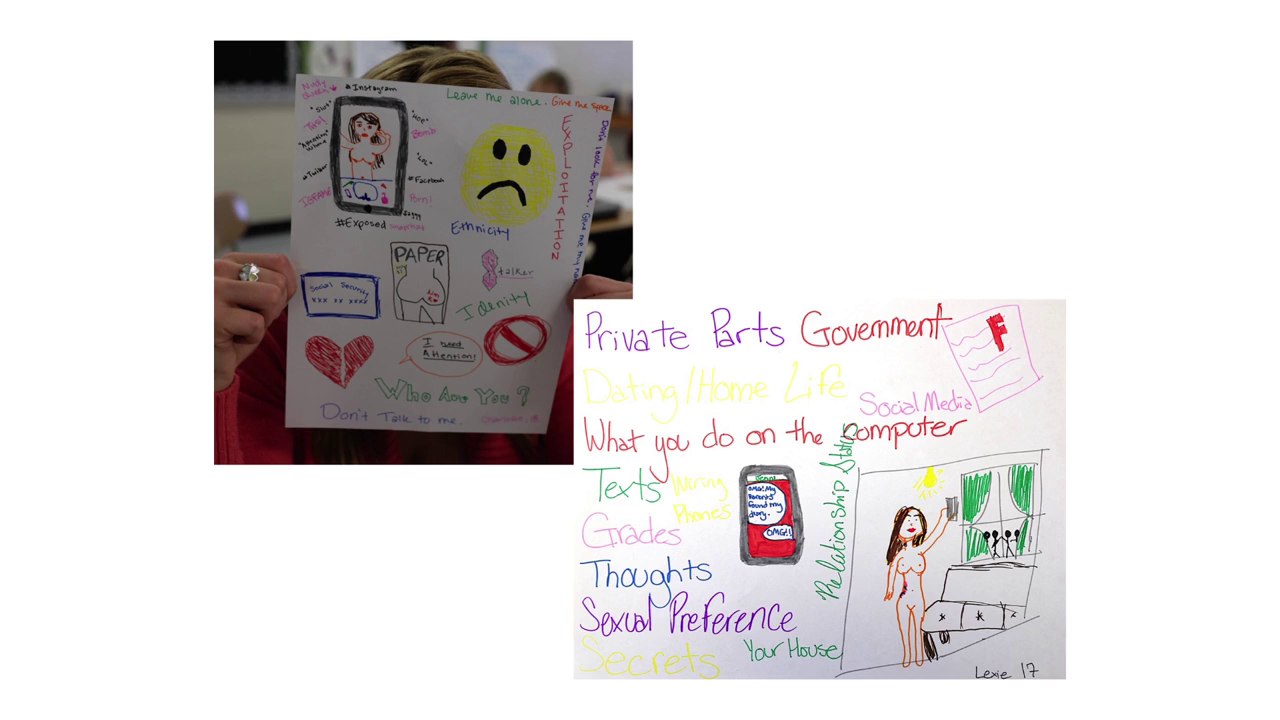
Even Kim Kardashian made an appearance here. That is the cover of Paper magazine. The high school students, especially the high school girls, were actually talking a lot about Kim and about naked pictures and naked selfies as they were doing these drawings, which was very interesting. In the bottom you can see there is a teenager taking a naked selfie. They all assured me that they and their friends would never do such a thing. They didn’t think that teenagers should be doing that but they wanted to draw about it.
We had a couple of people who talked about implications of privacy invasions including implications for your job. That if you post things on Facebook you could actually get fired for it. We have quite a few of these sort of privacy collages that bring in lots of different concepts of privacy and deal with both the physical space as well as electronic and surveillance.
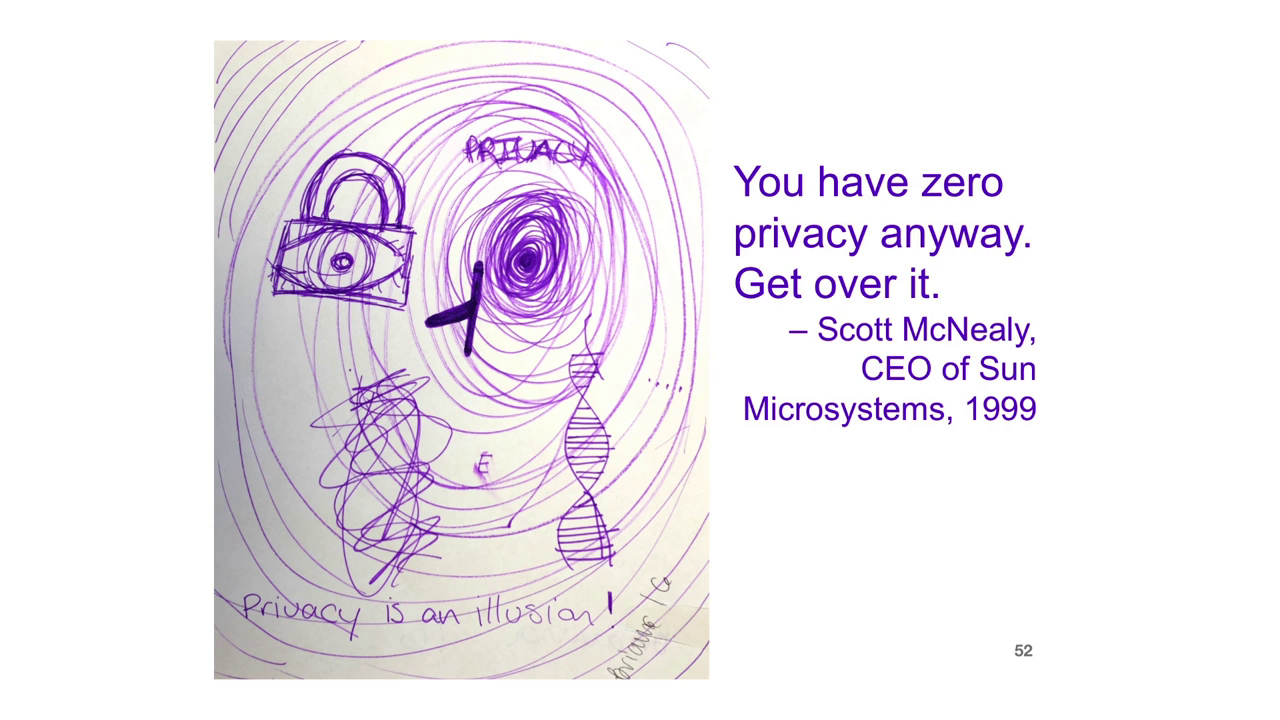
And then we had the people who said “Nope, you don’t have privacy. Privacy is an illusion.” I really like the spiral and the illusion that we see here. And there are certainly some corporate people who’ve expressed similar sentiments.
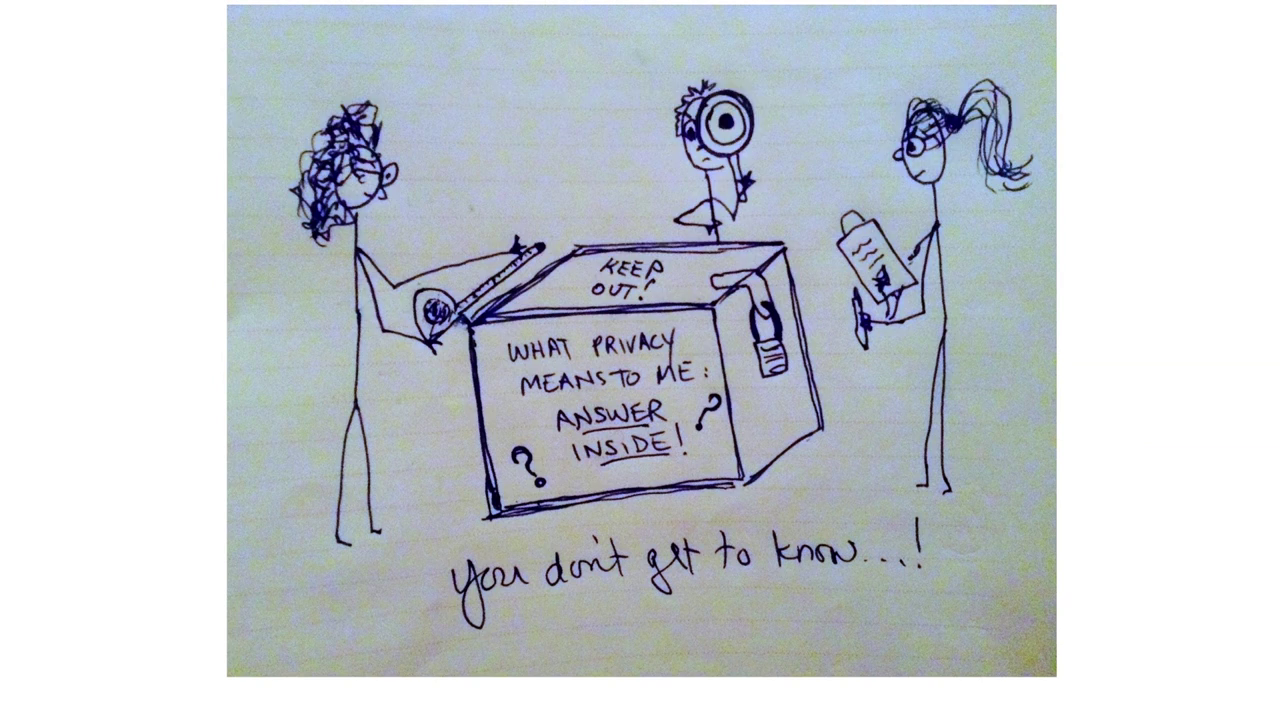
And then finally this came from an MTurker who his response to us as researchers asking him to draw privacy for a dollar is “You don’t get to know.” That was kind of interesting.
So as I said we are putting this together into a book chapter and also a web site. And version 1 of the web site was created today, in the past few hours. And so you can actually check it out on our web server. Our plan is to put all of the images that we collected there, tag them so that they’re searchable by different tags, and then ultimately have an upload feature so that people can contribute to our Privacy Illustrated web site.
So I’ll end there. Thank you.
